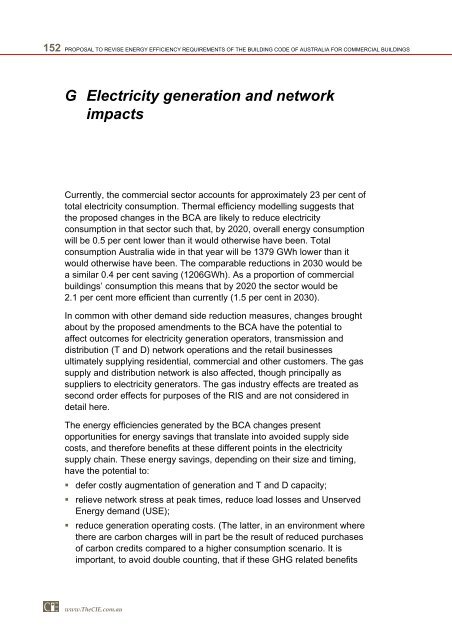PDF | 2 MB - Australian Building Codes Board
PDF | 2 MB - Australian Building Codes Board
PDF | 2 MB - Australian Building Codes Board
You also want an ePaper? Increase the reach of your titles
YUMPU automatically turns print PDFs into web optimized ePapers that Google loves.
152 PROPOSAL TO REVISE ENERGY EFFICIENCY REQUIREMENTS OF THE BUILDING CODE OF AUSTRALIA FOR COMMERCIAL BUILDINGS<br />
G Electricity generation and network<br />
impacts<br />
Currently, the commercial sector accounts for approximately 23 per cent of<br />
total electricity consumption. Thermal efficiency modelling suggests that<br />
the proposed changes in the BCA are likely to reduce electricity<br />
consumption in that sector such that, by 2020, overall energy consumption<br />
will be 0.5 per cent lower than it would otherwise have been. Total<br />
consumption Australia wide in that year will be 1379 GWh lower than it<br />
would otherwise have been. The comparable reductions in 2030 would be<br />
a similar 0.4 per cent saving (1206GWh). As a proportion of commercial<br />
buildings’ consumption this means that by 2020 the sector would be<br />
2.1 per cent more efficient than currently (1.5 per cent in 2030).<br />
In common with other demand side reduction measures, changes brought<br />
about by the proposed amendments to the BCA have the potential to<br />
affect outcomes for electricity generation operators, transmission and<br />
distribution (T and D) network operations and the retail businesses<br />
ultimately supplying residential, commercial and other customers. The gas<br />
supply and distribution network is also affected, though principally as<br />
suppliers to electricity generators. The gas industry effects are treated as<br />
second order effects for purposes of the RIS and are not considered in<br />
detail here.<br />
The energy efficiencies generated by the BCA changes present<br />
opportunities for energy savings that translate into avoided supply side<br />
costs, and therefore benefits at these different points in the electricity<br />
supply chain. These energy savings, depending on their size and timing,<br />
have the potential to:<br />
• defer costly augmentation of generation and T and D capacity;<br />
• relieve network stress at peak times, reduce load losses and Unserved<br />
Energy demand (USE);<br />
• reduce generation operating costs. (The latter, in an environment where<br />
there are carbon charges will in part be the result of reduced purchases<br />
of carbon credits compared to a higher consumption scenario. It is<br />
important, to avoid double counting, that if these GHG related benefits<br />
www.TheCIE.com.au
















